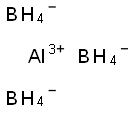Volatile, pyrophoric liquid.
Reducing agent; preparation of borohydrides of heavy metals; fuel for jet engines and rockets.
A clear, colorless liquid. Slightly denser than water. Contact causes burns to skin, eyes, and mucous membranes. Toxic by ingestion, inhalation and skin absorption. Used to make other chemicals.
Pyrophoric and explodes in oxygen, but only in the the presence of traces of moisture. Reacts vigorously with water, liberating hydrogen [Merck 11th ed. 1989]. Will flame when in contact with water [Ellern 1968 p. 45].
A powerful reducing agent. Reacts rapidly and dangerously with oxygen and with other oxidizing agents, even weak ones. Incompatible with acids, alcohols, amines, and aldehydes. The borohydride reacts with alkenes and in the presence of oxygen, combustion is initiated even in the absence of moisture. Butene explodes after an induction period, while butadiene explodes immediately. Reaction with dimethylaminoborane or dimethylaminodiborane gives an oily substance which ignites in air and reacts violently with water, [J. Amer. Chem. Soc., 1951, 73, 953].
Ignites spontaneously in air, reacts violently with water.
Fire will produce irritating, corrosive and/or toxic gases. Inhalation of decomposition products may cause severe injury or death. Contact with substance may cause severe burns to skin and eyes. Runoff from fire control may cause pollution.
Flammable/combustible material. May ignite on contact with moist air or moisture. May burn rapidly with flare-burning effect. Some react vigorously or explosively on contact with water. Some may decompose explosively when heated or involved in a fire. May re-ignite after fire is extinguished. Runoff may create fire or explosion hazard. Containers may explode when heated.
A poison. Spontaneously flammable in air. Explodes in oxygen with traces of water. Incompatible with alkenes and water. See also ALUMINUM COMPOUNDS and BORON COMPOUNDS.
